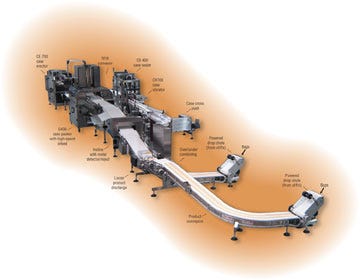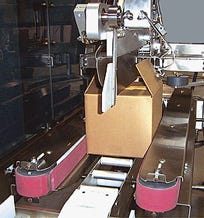
A major producer of individual quick-frozen vegetables needed new case-packing lines to handle the output from six vertical form/fill/seal machines. They called on Fallas Automation (www.fallasautomation.com) to design and build three new, high-speed, fully integrated case-packing lines to handle increased output from the machines, while maintaining maximum efficiency. With innovative thinking, Fallas supplied the three lines, each of which can handle the output of two high-speed machines at a combined rate of 180 bags/min.
The Fallas operation starts where the bags of frozen vegetables discharge from the bagger drop tubes. Fallas provided patented, powered drop chutes for the bags dropping from the machines instead of the typical static chutes. These provide positive control of the bags and prevent bags from rolling or standing up. The bags from one vf/f/s machine discharge onto an upper conveyor, while the bags from the other machine discharge onto a separate lower conveyor. The bags are combined onto the upper conveyor using Fallas' over-and-under combiner system. To prevent loose product from being conveyed to the case packer, bags leaving the combining station pass over rollers that support the bags, but allow loose product to fall into catch pans below. The bags then pass through a metal-detection station, where Fallas integrated the customer's metal detector with a sanitary stainless-steel conveyor with a reject mechanism.

To view a white paper from Fallas Automation about high-flexibility case packing, go to www.packagingdigest.com/ technology/Fallas
The product then travels to the Fallas Model G400-HS gravity drop packer. The vegetable plant runs a variety of case sizes and configurations, all of which must be accommodated by the packer. One typical arrangement is a 12-pack consisting of three layers containing four bags each. To achieve this arrangement, the bags pass across the patented Fallas infeed system that provides the proper grouping. This system consists of four short conveyors arranged in a series. A sensor counts the bags entering the system and their speed, and it speeds up or slows down the first three conveyors to bring the four bags that make up one layer together in a group. Depending on what the plant wants, the bags can be spaced anywhere from being just slightly touching to overlapping so that they provide a more dense pack.
Corrugated cases are erected at 30 cases/min on the Fallas Model CE700 case erector. Case blanks enter the machine from an easy-to-load magazine, and case opening, squaring and bottom-flap closing are all cam-driven operations. The case bottoms are taped, and the cases drop onto the conveyor feeding the case packer with the open end facing upward. Cases then enter the case packer for loading.
The last conveyor of the product-infeed system, which Fallas calls a bull-nose belt, is actually inside the case packer, and when the four bags enter the unit, this belt retracts, and the bags drop into a cradle that Fallas calls a Bombay. The bottom plate of the Bombay is split down the center, and the two sides open downward like bomb-bay doors and allow the bags to drop into the case. The drop is minimized by a tool-less, vertically adjustable case conveyor. Filled cases exit the packer and travel to a smart-case cross-push unit that transfers the cases into lugs on a conveyor that squares up the cases.

The cross-push unit has a sensor that detects the lugs on this conveyor, and it times the case pusher, so that the cases enter the lug conveyor between the lugs. This is necessary to ensure the case is square as it passes by the labeler. At this point, the cases are oriented crosswise on the conveyor, so they go past a stationary arm that turns them to travel in the proper length-wise orientation.
Some cases at the frozen-vegetable plant were undersized, so that bags of product protruded above the score line. To remedy this problem, Fallas provided its Model CV700 case vibrator ahead of the Model CS400 case sealer. The vibrator bounces the cases up and down and is also equipped with a plate that descends to push the bags down. This unit is equipped with a plow that closes the front minor flap and a powered arm that closes the rear minor flap. The cases then enter the Model CS400 case sealer, where powered major flap folders close the top flaps, after which the top is taped shut. The unit features powered side belts to control the cases.


The sealed cases are conveyed to an integrated RFID station supplied by the vegetable company, where RFID tags are applied. The cases are then transported to a palletizer. The entire system required automated washdown for time savings during sanitary cleanup, so Fallas installed spray nozzles on all of the conveyors.
The entire end-of-line packaging system supplied by Fallas Automation is controlled from the programmable-logic controller on the case packer. The operator sets the line speed and operating parameters at this machine. Sensors along the line automatically shut down the individual pieces of equipment if cases back up at any point, and the case-packer PLC also communicates with the vf/f/s machines and the palletizer.
"The benefits of using Fallas case-packing systems are labor savings, increased productivity and a proven track record," says Fallas president David Fallas. "Fallas stainless-steel case packing systems were designed from the outset to perform in harsh, washdown environments for many years, with the least amount of maintenance and the highest performance, flexibility and efficiency."
More information is available:
Fallas Automation, 254/772-9524. www.fallasautomation.com.
About the Author(s)
You May Also Like


